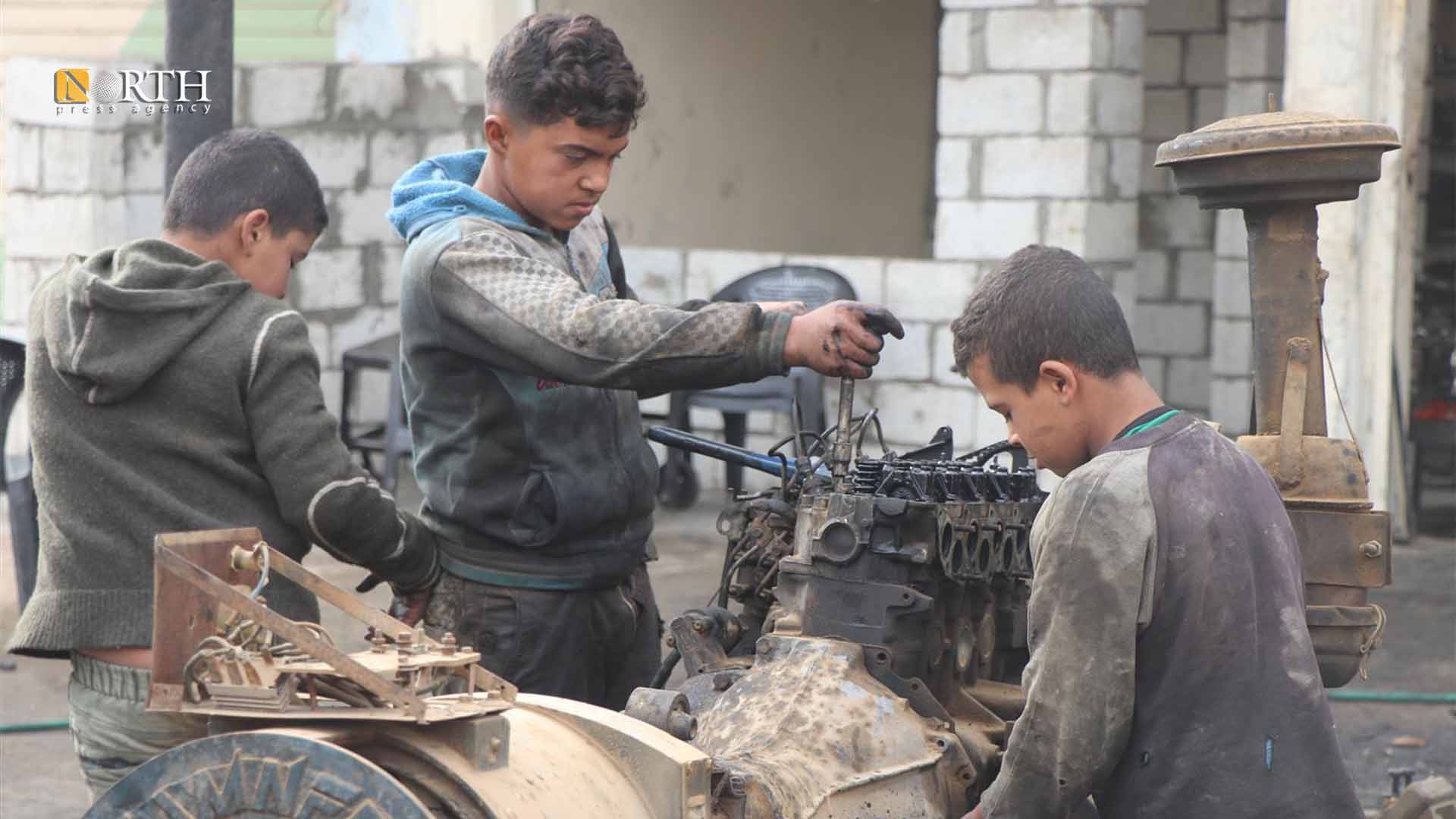HASAKAH, Syria (North Press) – the 12-year-old Ali Khalaf, who was displaced from Arisha village, works in a mechanic workshop in the industrial zone of Tel Tamr, northeastern Syria. The poor living condition of his family pushed him to work in this difficult profession to help his father support his family.
The industrial zone in Tel Tamr is the most prominent destination for children who have entered the labor market, hoping to acquire a profession with industrialists.
Khalaf’s family currently lives in the village of Tel Hafyan (two kilometers south of Tel Tamr), and the father works as an employee at the Power Department to support his family of nine.
The child told North Press that he could barely know the alphabet even though he continued attending school until fifth grade.
“It has been a year and a half since my work in the industrial zone after I left school (…) to learn the profession and help my family.”
At the school of the village of Tel Hafyan, in which the family of the child lives, in addition to other displaced people from the countryside who fled the Turkish attacks in 2019, while the children of the town go to school north of the village.
He works six days a week, ten hours a day, for 8,000 SYP ($2,5) per week, while the wages of others vary greatly according to the age and the experience.
The phenomenon of child labor within the city and its countryside is increasing dramatically and constantly as a result of the deteriorating living situation and the displacement of many families to the region, which suffers, like the rest of the country, from difficult economic conditions.
Child labor is more concentrated in the industrial zone, in food stores, and among street vendors.
Dangerous works
The work of Khalaf is classified among the very dangerous jobs for children, according to a circular issued by the Autonomous Administration of North and East Syria last March.
The goal of the circulars issued is to prevent child labor, which has dramatically increased throughout the entire Syrian geography as a result of the ongoing war, and its effects on the situation of children and childhood, according to Child Protection Office.
One of the circulars stated: “It is strictly forbidden to employ children under the age of ten.|”
Children from 10 to 15 are allowed to work according to specific conditions and certain professions such as in mobile phone shops, computer stores, pharmacies, and other electronic shops for a maximum of 6 hours a day, provided that they do not leave school.
In a blacksmith’s workshop in the industrial zone, the 17-year-old Abdullah Omar and another child start to work every morning after dropping out of the school.
Omar considered his lack of mastery in writing and reading despite his studies until the middle school stage, the main reason for start learning a profession in the local markets.
Despite the hardship of working for about ten hours a day for 20,000 SYP ($7) per week, he says he never thinks about returning to school, and that he prefers to help his family.
According to the Autonomous Administration’s circular, those between the ages of 15 and 18 must submit evidence that they have completed the ninth grade, in order to be allowed to work.
It is also stipulated that their work should not be classified as dangerous work, and that their working hours during the day should not exceed six hours, including one hour break.
2,000 students
Khaled Jabr, co-chair of the Child Protection Office in Armed Conflicts in Hasakah, considered that the deterioration of living conditions is not a justification for putting children in jobs that deprives children of their childhood, interferes with their ability to attend regular school, and is mentally, physically, socially and morally harmful.
“The essential place for children is definitely their school,” Jabr stressed.
Statistics from the Child Protection Office indicate that nearly 2,000 children in the Jazira Region work in dangerous jobs.
60% of children in Syria are food insecure, and more than half of them lack education, according to what the United Nations announced on the occasion of World Children’s Day for the year 2021.
The UNICEF estimates that 2.5 million children in Syria do not currently receive education, and another 1.6 million are also threatened with the same fate.
Acquiring a profession
Maher al-Haddad, the owner of blacksmith workshop in the industrial zone of Tel Tamr, does not deny that industrial occupations are difficult for children.
However, he believes that the majority of children come to learn a profession after leaving school.
Al-Haddad has two children working for him, he said the hardships of work tire them out, “but gaining a profession will benefit them in the future.”
He added that the reason behind choosing stressful professions for children is due to the desire of parents to teach their children money-generating professions and get a good wage compared to what the child would get if he worked in less effort jobs.
“Also, adult workers do not accept such tasks in return for low wages. The wages range between 8,000, 10,000 and 12,000 per week, according to the worker’s age, and his knowledge of the profession,” he added.
A few meters away from the workshop, children stand on the highway carrying bags filled with damaged nylon and aluminum pieces, collected from neighborhoods and markets, with the aim of selling them.
The head of the Child Protection Office said, “There will be steps in the future by the Autonomous Administration to find a solution for this phenomena or at least, to limit it to a specific point.”
He added, “We are currently studying this matter and future projects will be carried out in cooperation with international organizations to reduce child labor.”

